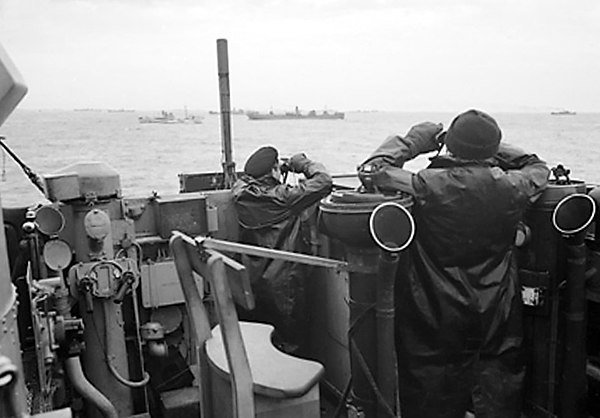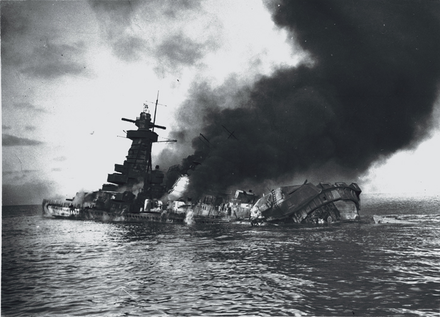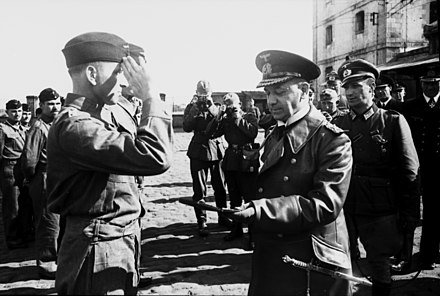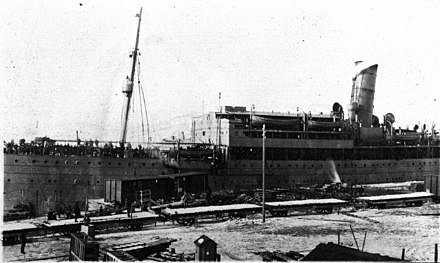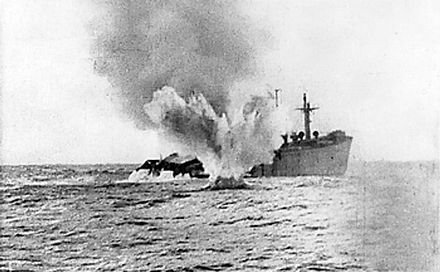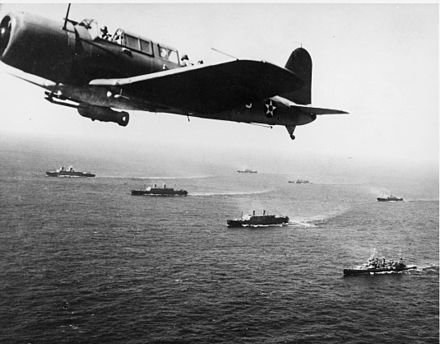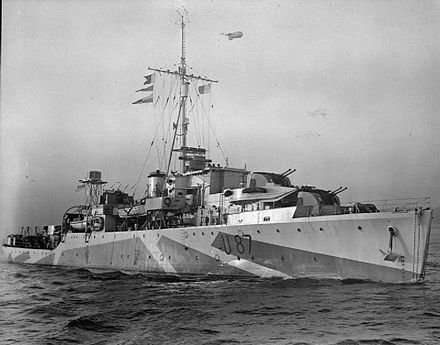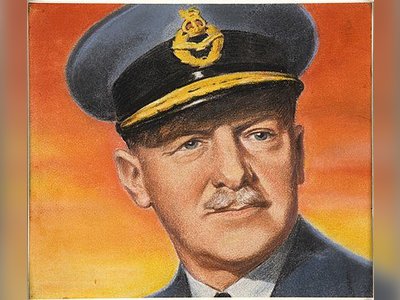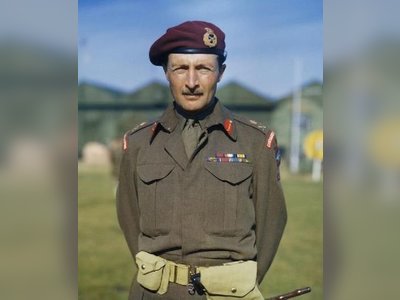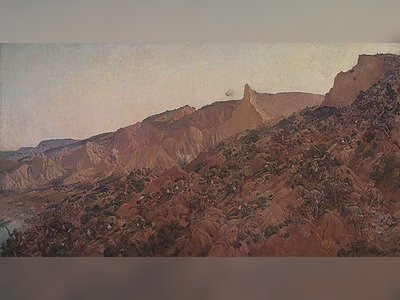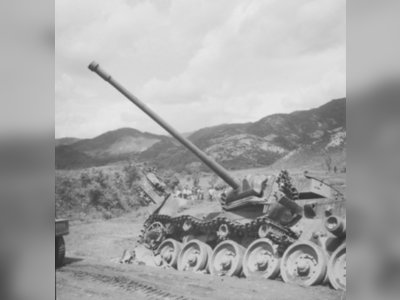Battle of the Atlantic
***TOO LONG*** 1939
1940
1941
1942
1943
1944
1945
Asia-Pacific
Mediterranean and Middle East
Other campaigns
Coups
The Battle of the Atlantic, the longest continuous military campaign in World War II, ran from 1939 to the defeat of Nazi Germany in 1945, covering a major part of the naval history of World War II. At its core was the Allied naval blockade of Germany, announced the day after the declaration of war, and Germany's subsequent counter-blockade. The campaign peaked from mid-1940 through to the end of 1943.
The Battle of the Atlantic pitted U-boats and other warships of the German Kriegsmarine (Navy) and aircraft of the Luftwaffe (Air Force) against the Royal Navy, Royal Canadian Navy, United States Navy, and Allied merchant shipping. Convoys, coming mainly from North America and predominantly going to the United Kingdom and the Soviet Union, were protected for the most part by the British and Canadian navies and air forces. These forces were aided by ships and aircraft of the United States beginning September 13, 1941. The Germans were joined by submarines of the Italian Regia Marina (Royal Navy) after Germany's Axis ally Italy entered the war on June 10, 1940.
As a small island country, the United Kingdom was highly dependent on imported goods. Britain required more than a million tons of imported material per week in order to survive and fight. In essence, the Battle of the Atlantic involved a tonnage war: the Allied struggle to supply Britain and the Axis attempt to stem the flow of merchant shipping that enabled Britain to keep fighting. From 1942 onward the Axis also sought to prevent the build-up of Allied supplies and equipment in the British Isles in preparation for the invasion of occupied Europe. The defeat of the U-boat threat was a prerequisite for pushing back the Axis in Western Europe. The outcome of the battle was a strategic victory for the Allies—the German blockade failed—but at great cost: 3,500 merchant ships and 175 warships were sunk in the Atlantic for the loss of 783 U-boats (the majority of them Type VII submarines) and 47 German surface warships, including 4 battleships (Bismarck, Scharnhorst, Gneisenau, and Tirpitz), 9 cruisers, 7 raiders, and 27 destroyers. Of the U-boats, 519 were sunk by British, Canadian, or other allied forces, while 175 were destroyed by American forces; 15 were destroyed by the Soviets and 73 were scuttled by their crews before the end of the war for various reasons.
The Battle of the Atlantic has been called the "longest, largest, and most complex" naval battle in history. The campaign started immediately after the European War began, during the so-called "Phoney War", and lasted more than five years, until the German surrender in May 1945. It involved thousands of ships in more than 100 convoy battles and perhaps 1,000 single-ship encounters, in a theatre covering millions of square miles of ocean. The situation changed constantly, with one side or the other gaining advantage, as participating countries surrendered, joined and even changed sides in the war, and as new weapons, tactics, counter-measures and equipment were developed by both sides. The Allies gradually gained the upper hand, overcoming German surface-raiders by the end of 1942 and defeating the U-boats by mid-1943, though losses due to U-boats continued until the war's end. British Prime Minister Winston Churchill later wrote "The only thing that really frightened me during the war was the U-boat peril. I was even more anxious about this battle than I had been about the glorious air fight called the 'Battle of Britain'."
Name
On 5 March 1941, First Lord of the Admiralty A. V. Alexander asked Parliament for "many more ships and great numbers of men" to fight "the Battle of the Atlantic", which he compared to the Battle of France, fought the previous summer. The first meeting of the Cabinet's "Battle of the Atlantic Committee" was on March 19. Churchill claimed to have coined the phrase "Battle of the Atlantic" shortly before Alexander's speech, but there are several examples of earlier usage.
Background
Following the use of unrestricted submarine warfare by Germany in the First World War, countries tried to limit or abolish, submarines. The effort failed. Instead, the London Naval Treaty required submarines to abide by "cruiser rules", which demanded they surface, search and place ship crews in "a place of safety" (for which lifeboats did not qualify, except under particular circumstances) before sinking them, unless the ship in question showed "persistent refusal to stop...or active resistance to visit or search". These regulations did not prohibit arming merchantmen, but doing so, or having them report contact with submarines (or raiders), made them de facto naval auxiliaries and removed the protection of the cruiser rules. This made restrictions on submarines effectively moot.
Early skirmishes (September 1939 – May 1940)
In 1939, the Kriegsmarine lacked the strength to challenge the combined British Royal Navy and French Navy (Marine Nationale) for command of the sea. Instead, German naval strategy relied on commerce raiding using capital ships, armed merchant cruisers, submarines and aircraft. Many German warships were already at sea when war was declared, including most of the available U-boats and the "pocket battleships" (Panzerschiffe) Deutschland and Admiral Graf Spee which had sortied into the Atlantic in August. These ships immediately attacked British and French shipping. U-30 sank the ocean liner SS Athenia within hours of the declaration of war—in breach of her orders not to sink passenger ships. The U-boat fleet, which was to dominate so much of the Battle of the Atlantic, was small at the beginning of the war; many of the 57 available U-boats were the small and short-range Type IIs, useful primarily for minelaying and operations in British coastal waters. Much of the early German anti-shipping activity involved minelaying by destroyers, aircraft and U-boats off British ports.
With the outbreak of war, the British and French immediately began a blockade of Germany, although this had little immediate effect on German industry. The Royal Navy quickly introduced a convoy system for the protection of trade that gradually extended out from the British Isles, eventually reaching as far as Panama, Bombay and Singapore. When the convoy system was first introduced however, Britain's Royal Admiralty strongly opposed the idea. Britain believed that the convoy would be a waste of ships that they could not afford to do, considering they might be needed in battle. Convoys allowed the Royal Navy to concentrate its escorts near the one place the U-boats were guaranteed to be found, the convoys. Each convoy consisted of between 30 and 70 mostly unarmed merchant ships.
Some British naval officials, particularly the First Lord of the Admiralty, Winston Churchill, sought a more 'offensive' strategy. The Royal Navy formed anti-submarine hunting groups based on aircraft carriers to patrol the shipping lanes in the Western Approaches and hunt for German U-boats. This strategy was deeply flawed because a U-boat, with its tiny silhouette, was always likely to spot the surface warships and submerge long before it was sighted. The carrier aircraft were little help; although they could spot submarines on the surface, at this stage of the war they had no adequate weapons to attack them, and any submarine found by an aircraft was long gone by the time surface warships arrived. The hunting group strategy proved a disaster within days. On 14 September 1939, Britain's most modern carrier, HMS Ark Royal, narrowly avoided being sunk when three torpedoes from U-39 exploded prematurely. U-39 was forced to surface and scuttle by the escorting destroyers, becoming the first U-boat loss of the war. Another carrier, HMS Courageous, was sunk three days later by U-29.
Escort destroyers hunting for U-boats continued to be a prominent, but misguided, technique of British anti-submarine strategy for the first year of the war. U-boats nearly always proved elusive, and the convoys, denuded of cover, were put at even greater risk.
German success in sinking Courageous was surpassed a month later when Günther Prien in U-47 penetrated the British base at Scapa Flow and sank the old battleship HMS Royal Oak at anchor, immediately becoming a hero in Germany.
In the South Atlantic, British forces were stretched by the cruise of Admiral Graf Spee, which sank nine merchant ships of 50,000 GRT in the South Atlantic and Indian Ocean during the first three months of war. The British and French formed a series of hunting groups including three battlecruisers, three aircraft carriers, and 15 cruisers to seek the raider and her sister Deutschland, which was operating in the North Atlantic. These hunting groups had no success until Admiral Graf Spee was caught off the mouth of the River Plate between Argentina and Uruguay by an inferior British force. After suffering damage in the subsequent action, she took shelter in neutral Montevideo harbour and was scuttled on 17 December 1939.
After this initial burst of activity, the Atlantic campaign quieted down. Admiral Karl Dönitz, commander of the U-boat fleet, had planned a maximum submarine effort for the first month of the war, with almost all the available U-boats out on patrol in September. That level of deployment could not be sustained; the boats needed to return to harbour to refuel, re-arm, re-stock supplies, and refit. The harsh winter of 1939–40, which froze over many of the Baltic ports, seriously hampered the German offensive by trapping several new U-boats in the ice. Hitler's plans to invade Norway and Denmark in the spring of 1940 led to the withdrawal of the fleet's surface warships and most of the ocean-going U-boats for fleet operations in Operation Weserübung.
The resulting Norwegian campaign revealed serious flaws in the magnetic influence pistol (firing mechanism) of the U-boats' principal weapon, the torpedo. Although the narrow fjords gave U-boats little room for manoeuvre, the concentration of British warships, troopships and supply ships provided countless opportunities for the U-boats to attack. Time and again, U-boat captains tracked British targets and fired, only to watch the ships sail on unharmed as the torpedoes exploded prematurely (due to the influence pistol), or hit and failed to explode (because of a faulty contact pistol), or ran beneath the target without exploding (due to the influence feature or depth control not working correctly). Not a single British warship was sunk by a U-boat in more than 20 attacks. As the news spread through the U-boat fleet, it began to undermine morale. The director in charge of torpedo development continued to claim it was the crews' fault. In early 1941, the problems were determined to be due to differences in the earth's magnetic fields at high latitudes and a slow leakage of high-pressure air from the submarine into the torpedo's depth regulation gear. These problems were solved by about March 1941, making the torpedo a formidable weapon. Similar problems plagued the US Navy's Mark 14 torpedo. The US ignored reports of German problems.
Early in the war, Dönitz submitted a memorandum to Grand Admiral Erich Raeder, the German navy's Commander-in-Chief, in which he estimated effective submarine warfare could bring Britain to its knees because of the country's dependence on overseas commerce. He advocated a system known as the Rudeltaktik (the so-called "wolf pack"), in which U-boats would spread out in a long line across the projected course of a convoy. Upon sighting a target, they would come together to attack en masse and overwhelm any escorting warships. While escorts chased individual submarines, the rest of the "pack" would be able to attack the merchant ships with impunity. Dönitz calculated 300 of the latest Atlantic Boats (the Type VII), would create enough havoc among Allied shipping that Britain would be knocked out of the war.
This was in stark contrast to the traditional view of submarine deployment up until then, in which the submarine was seen as a lone ambusher, waiting outside an enemy port to attack ships entering and leaving. This had been a very successful tactic used by British submarines in the Baltic and Bosporus during World War I, but it could not be successful if port approaches were well patrolled. There had also been naval theorists who held that submarines should be attached to a fleet and used like destroyers; this had been tried by the Germans at Jutland with poor results, since underwater communications were in their infancy. (Interwar exercises had proven the idea faulty.) The Japanese also adhered to the idea of a fleet submarine, following the doctrine of Mahan, and never used their submarines either for close blockade or convoy interdiction. The submarine was still looked upon by much of the naval world as "dishonourable", compared to the prestige attached to capital ships. This was true in the Kriegsmarine as well; Raeder successfully lobbied for the money to be spent on capital ships instead.
The Royal Navy's main anti-submarine weapon before the war was the inshore patrol craft, which was fitted with hydrophones and armed with a small gun and depth charges. The Royal Navy, like most, had not considered anti-submarine warfare as a tactical subject during the 1920s and 1930s. Unrestricted submarine warfare had been outlawed by the London Naval Treaty; anti-submarine warfare was seen as 'defensive' rather than dashing; many naval officers believed anti-submarine work was drudgery similar to mine sweeping; and ASDIC was believed to have rendered submarines impotent. Although destroyers also carried depth charges, it was expected these ships would be used in fleet actions rather than coastal patrol, so they were not extensively trained in their use. The British, however, ignored the fact that arming merchantmen, as Britain did from the start of the war, removed them from the protection of the "cruiser rules", and the fact that anti-submarine trials with ASDIC had been conducted in ideal conditions.
British situation
The German occupation of Norway in April 1940, the rapid conquest of the Low Countries and France in May and June, and the Italian entry into the war on the Axis side in June transformed the war at sea in general and the Atlantic campaign in particular in three main ways:
The completion of Hitler's campaign in Western Europe meant U-boats withdrawn from the Atlantic for the Norwegian campaign now returned to the war on trade. So at the very time the number of U-boats on patrol in the Atlantic began to increase, the number of escorts available for the convoys was greatly reduced. The only consolation for the British was that the large merchant fleets of occupied countries like Norway and the Netherlands came under British control. After the German occupation of Denmark and Norway, Britain occupied Iceland and the Faroe Islands, establishing bases there and preventing a German takeover.
It was in these circumstances that Winston Churchill, who had become Prime Minister on 10 May 1940, first wrote to President Franklin Roosevelt to request the loan of fifty obsolescent US Navy destroyers. This eventually led to the "Destroyers for Bases Agreement" (effectively a sale but portrayed as a loan for political reasons), which operated in exchange for 99-year leases on certain British bases in Newfoundland, Bermuda and the West Indies, a financially advantageous bargain for the United States but militarily beneficial for Britain, since it effectively freed up British military assets to return to Europe. A significant percentage of the US population opposed entering the war, and some American politicians (including the US Ambassador to Britain, Joseph P. Kennedy) believed that Britain and its allies might actually lose. The first of these destroyers were only taken over by their British and Canadian crews in September, and all needed to be rearmed and fitted with ASDIC. It was to be many months before these ships contributed to the campaign.
The early U-boat operations from the French bases were spectacularly successful. This was the heyday of the great U-boat aces like Günther Prien of U-47, Otto Kretschmer (U-99), Joachim Schepke (U-100), Engelbert Endrass (U-46), Victor Oehrn (U-37) and Heinrich Bleichrodt (U-48). U-boat crews became heroes in Germany. From June until October 1940, over 270 Allied ships were sunk: this period was referred to by U-boat crews as "the Happy Time" ("Die Glückliche Zeit"). Churchill would later write: "...the only thing that ever frightened me during the war was the U-boat peril".
The biggest challenge for the U-boats was to find the convoys in the vastness of the ocean. The Germans had a handful of very long-range Focke-Wulf Fw 200 Condor aircraft based at Bordeaux and Stavanger, which were used for reconnaissance. The Condor was a converted civilian airliner—a stop-gap solution for Fliegerführer Atlantik. Due to ongoing friction between the Luftwaffe and Kriegsmarine, the primary source of convoy sightings was the U-boats themselves. Since a submarine's bridge was very close to the water, their range of visual detection was quite limited.
The best source proved to be the codebreakers of B-Dienst who had succeeded in deciphering the British Naval Cypher No. 3, allowing the Germans to estimate where and when convoys could be expected.
In response, the British applied the techniques of operations research to the problem and came up with some counter-intuitive solutions for protecting convoys. They realised that the area of a convoy increased by the square of its perimeter, meaning the same number of ships, using the same number of escorts, was better protected in one convoy than in two. A large convoy was as difficult to locate as a small one. Moreover, reduced frequency also reduced the chances of detection, as fewer large convoys could carry the same amount of cargo, while large convoys take longer to assemble. Therefore, a few large convoys with apparently few escorts were safer than many small convoys with a higher ratio of escorts to merchantmen.
Instead of attacking the Allied convoys singly, U-boats were directed to work in wolf packs (Rudel) coordinated by radio. The boats spread out into a long patrol line that bisected the path of the Allied convoy routes. Once in position, the crew studied the horizon through binoculars looking for masts or smoke, or used hydrophones to pick up propeller noises. When one boat sighted a convoy, it would report the sighting to U-boat headquarters, shadowing and continuing to report as needed until other boats arrived, typically at night. Instead of being faced by single submarines, the convoy escorts then had to cope with groups of up to half a dozen U-boats attacking simultaneously. The most daring commanders, such as Kretschmer, penetrated the escort screen and attacked from within the columns of merchantmen. The escort vessels, which were too few in number and often lacking in endurance, had no answer to multiple submarines attacking on the surface at night as their ASDIC only worked well against underwater targets. Early British marine radar, working in the metric bands, lacked target discrimination and range. Moreover, corvettes were too slow to catch a surfaced U-boat.
Pack tactics were first used successfully in September and October 1940 to devastating effect, in a series of convoy battles. On September 21, convoy HX 72 of 42 merchantmen was attacked by a pack of four U-boats, which sank eleven ships and damaged two over the course of two nights. In October, the slow convoy SC 7, with an escort of two sloops and two corvettes, was overwhelmed, losing 59% of its ships. The battle for HX 79 in the following days was in many ways worse for the escorts than for SC 7. The loss of a quarter of the convoy without any loss to the U-boats, despite a very strong escort (two destroyers, four corvettes, three trawlers, and a minesweeper) demonstrated the effectiveness of the German tactics against the inadequate British anti-submarine methods. On 1 December, seven German and three Italian submarines caught HX 90, sinking 10 ships and damaging three others. The success of pack tactics against these convoys encouraged Admiral Dönitz to adopt the wolf pack as his primary tactic.
At the end of the year 1940, the Admiralty viewed the number of ships sunk with growing alarm. Damaged ships might survive but could be out of commission for long periods. Two million gross tons of merchant shipping—13 % percent of the fleet available to the British—were under repair and unavailable, which had the same effect in slowing down cross-Atlantic supplies.
Nor were the U-boats the only threat. Following some early experience in support of the war at sea during Operation Weserübung, the Luftwaffe began to take a toll of merchant ships. Martin Harlinghausen and his recently established command—Fliegerführer Atlantik—contributed small numbers of aircraft to the Battle of the Atlantic from 1941 onwards. These were primarily Fw 200 Condors and (later) Junkers Ju 290s, used for long-range reconnaissance. The Condors also bombed convoys that were beyond land-based fighter cover and thus defenceless. Initially, the Condors were very successful, claiming 365,000 tons of shipping in early 1941. These aircraft were few in number, however, and directly under Luftwaffe control; in addition, the pilots had little specialised training for anti-shipping warfare, limiting their effectiveness.
The Germans received help from their allies. From August 1940, a flotilla of 27 Italian submarines operated from the BETASOM base in Bordeaux to attack Allied shipping in the Atlantic, initially under the command of Rear Admiral Angelo Parona, then of Rear Admiral Romolo Polacchini and finally of Ship-of-the-Line Captain Enzo Grossi. The Italian submarines had been designed to operate in a different way than U-boats, and they had a number of flaws that needed to be corrected (for example huge conning towers, slow speed when surfaced, lack of modern torpedo fire control), which meant that they were ill-suited for convoy attacks, and performed better when hunting down isolated merchantmen on distant seas, taking advantage of their superior range and living standards. While initial operation met with little success (only 65343 GRT sunk between August and December 1940), the situation improved gradually over time, and up to August 1943 the 32 Italian submarines that operated there sank 109 ships of 593,864 tons, for 17 subs lost in return, giving them a subs-lost-to-tonnage sunk ratio similar to Germany's in the same period, and higher overall. The Italians were also successful with their use of "human torpedo" chariots, disabling several British ships in Gibraltar.
Despite these successes, the Italian intervention was not favourably regarded by Dönitz, who characterised Italians as "inadequately disciplined" and "unable to remain calm in the face of the enemy". They were unable to co-operate in wolf pack tactics or even reliably report contacts or weather conditions, and their area of operation was moved away from those of the Germans.
Amongst the more successful Italian submarine commanders who operated in the Atlantic were Carlo Fecia di Cossato, commander of the submarine Enrico Tazzoli, and Gianfranco Gazzana-Priaroggia, commander of Archimede and then of Leonardo da Vinci.
ASDIC
ASDIC (also known as SONAR) was a central feature of the Battle of the Atlantic. One crucial development was the integration of ASDIC with a plotting table and weapons (depth charges and later Hedgehog) to make an anti-submarine warfare system.
ASDIC produced an accurate range and bearing to the target, but could be fooled by thermoclines, currents or eddies, and schools of fish, so it needed experienced operators to be effective. ASDIC was effective only at low speeds. Above 15 knots (28 km/h) or so, the noise of the ship going through the water drowned out the echoes.
The early wartime Royal Navy procedure was to sweep the ASDIC in an arc from one side of the escort's course to the other, stopping the transducer every few degrees to send out a signal. Several ships searching together would be used in a line, 1–1.5 mi (1.6–2.4 km) apart. If an echo was detected, and if the operator identified it as a submarine, the escort would be pointed towards the target and would close at a moderate speed; the submarine's range and bearing would be plotted over time to determine course and speed as the attacker closed to within 1,000 yards (910 m). Once it was decided to attack, the escort would increase speed, using the target's course and speed data to adjust her own course. The intention was to pass over the submarine, rolling depth charges from chutes at the stern at even intervals, while throwers fired further charges some 40 yd (37 m) to either side. The intention was to lay a 'pattern' like an elongated diamond, hopefully with the submarine somewhere inside it. To effectively disable a submarine, a depth charge had to explode within about 20 ft (6.1 m). Since early ASDIC equipment was poor at determining depth, it was usual to vary the depth settings on part of the pattern.
There were disadvantages to the early versions of this system. Exercises in anti-submarine warfare had been restricted to one or two destroyers hunting a single submarine whose starting position was known, and working in daylight and calm weather. U-boats could dive far deeper than British or American submarines (over 700 feet (210 m)), well below the 350-foot (110 m) maximum depth charge setting of British depth charges. More importantly, early ASDIC sets could not look directly down, so the operator lost contact on the U-boat during the final stages of the attack, a time when the submarine would certainly be manoeuvring rapidly. The explosion of a depth charge also disturbed the water, so ASDIC contact was very difficult to regain if the first attack had failed. It enabled the U-boat to change position with impunity.
The belief that ASDIC had solved the submarine problem, the acute budgetary pressures of the Great Depression, and the pressing demands for many other types of rearmament meant little was spent on anti-submarine ships or weapons. Most British naval spending, and many of the best officers, went into the battlefleet. Critically, the British expected, as in the First World War, German submarines would be coastal craft and only threaten harbour approaches. As a result, the Royal Navy entered the Second World War in 1939 without enough long-range escorts to protect ocean-going shipping, and there were no officers with experience of long-range anti-submarine warfare. The situation in Royal Air Force Coastal Command was even more dire: patrol aircraft lacked the range to cover the North Atlantic and could typically only machine-gun the spot where they saw a submarine dive.
Despite their success, U-boats were still not recognised as the foremost threat to the North Atlantic convoys. With the exception of men like Dönitz, most naval officers on both sides regarded surface warships as the ultimate commerce destroyers.
For the first half of 1940, there were no German surface raiders in the Atlantic because the German Fleet had been concentrated for the invasion of Norway. The sole pocket battleship raider, Admiral Graf Spee, had been stopped at the Battle of the River Plate by an inferior and outgunned British squadron. From the summer of 1940 a small but steady stream of warships and armed merchant raiders set sail from Germany for the Atlantic.
The power of a raider against a convoy was demonstrated by the fate of convoy HX 84, attacked by the pocket battleship Admiral Scheer on 5 November 1940. Admiral Scheer quickly sank five ships and damaged several others as the convoy scattered. Only the sacrifice of the escorting armed merchant cruiser HMS Jervis Bay (whose commander, Edward Fegen, was awarded a posthumous Victoria Cross) and failing light allowed the other merchantmen to escape. The British now suspended North Atlantic convoys and the Home Fleet put to sea to try to intercept Admiral Scheer. The search failed and Admiral Scheer disappeared into the South Atlantic. She reappeared in the Indian Ocean the following month.
Other German surface raiders now began to make their presence felt. On Christmas Day 1940, the cruiser Admiral Hipper attacked the troop convoy WS 5A, but was driven off by the escorting cruisers.Admiral Hipper had more success two months later, on 12 February 1941, when she found the unescorted convoy SLS 64 of 19 ships and sank seven of them. In January 1941, the formidable (and fast) battleships Scharnhorst and Gneisenau, which outgunned any Allied ship that could catch them, put to sea from Germany to raid the shipping lanes in Operation Berlin. With so many German raiders at large in the Atlantic, the British were forced to provide battleship escorts to as many convoys as possible. This twice saved convoys from slaughter by the German battleships. In February, the old battleship HMS Ramillies deterred an attack on HX 106. A month later, SL 67 was saved by the presence of HMS Malaya.
In May, the Germans mounted the most ambitious raid of all: Operation Rheinübung. The new battleship Bismarck and the cruiser Prinz Eugen put to sea to attack convoys. A British fleet intercepted the raiders off Iceland. In the Battle of the Denmark Strait, the battlecruiser HMS Hood was blown up and sunk, but Bismarck was damaged and had to run to France.Bismarck nearly reached her destination, but was disabled by an airstrike from the carrier Ark Royal, and then sunk by the Home Fleet the next day. Her sinking marked the end of the warship raids. The advent of long-range search aircraft, notably the unglamorous but versatile PBY Catalina, largely neutralised surface raiders.
In February 1942, Scharnhorst, Gneisenau and Prinz Eugen moved from Brest back to Germany in the "Channel Dash". While this was an embarrassment for the British, it was the end of the German surface threat in the Atlantic. The loss of Bismarck, the destruction of the network of supply ships that supported surface raiders, the repeated damage to the three ships by air raids, the entry of the United States into the war, Arctic convoys, and the perceived invasion threat to Norway had persuaded Hitler and the naval staff to withdraw.
War had come too early for the German naval expansion project Plan Z. Battleships powerful enough to destroy any convoy escort, with escorts able to annihilate the convoy, were never achieved. Although the number of ships the raiders sank was relatively small compared with the losses to U-boats, mines, and aircraft, their raids severely disrupted the Allied convoy system, reduced British imports, and strained the Home Fleet.
Escort groups (March–May 1941)
The disastrous convoy battles of October 1940 forced a change in British tactics. The most important of these was the introduction of permanent escort groups to improve the co-ordination and effectiveness of ships and men in battle. British efforts were helped by a gradual increase in the number of escort vessels available as the old ex-American destroyers and the new British- and Canadian-built Flower-class corvettes were now coming into service in numbers. Many of these ships became part of the huge expansion of the Royal Canadian Navy, which grew from a handful of destroyers at the outbreak of war to take an increasing share of convoy escort duty. Others of the new ships were crewed by Free French, Norwegian and Dutch, but these were a tiny minority of the total number, and directly under British command. By 1941 American public opinion had begun to swing against Germany, but the war was still essentially Great Britain and the Empire against Germany.
Initially, the new escort groups consisted of two or three destroyers and half a dozen corvettes. Since two or three of the group would usually be in dock repairing weather or battle damage, the groups typically sailed with about six ships. The training of the escorts also improved as the realities of the battle became obvious. A new base was set up at Tobermory in the Hebrides to prepare the new escort ships and their crews for the demands of battle under the strict regime of Vice-Admiral Gilbert O. Stephenson.
In February 1941, the Admiralty moved the headquarters of Western Approaches Command from Plymouth to Liverpool, where much closer contact with, and control of, the Atlantic convoys was possible. Greater co-operation with supporting aircraft was also achieved. In April, the Admiralty took over operational control of Coastal Command aircraft. At a tactical level, new short-wave radar sets that could detect surfaced U-boats and were suitable for both small ships and aircraft began to arrive during 1941.
The impact of these changes first began to be felt in the battles during the spring of 1941. In early March, Prien in U-47 failed to return from patrol. Two weeks later, in the battle of Convoy HX 112, the newly formed 3rd Escort Group of four destroyers and two corvettes held off the U-boat pack. U-100 was detected by the primitive radar on the destroyer HMS Vanoc, rammed and sunk. Shortly afterwards U-99 was also caught and sunk, its crew captured. Dönitz had lost his three leading aces: Kretschmer, Prien, and Schepke.
Dönitz now moved his wolf packs further west, in order to catch the convoys before the anti-submarine escort joined. This new strategy was rewarded at the beginning of April when the pack found Convoy SC 26 before its anti-submarine escort had joined. Ten ships were sunk, but another U-boat was lost.
In June 1941, the British decided to provide convoy escort for the full length of the North Atlantic crossing. To this end, the Admiralty asked the Royal Canadian Navy on May 23, to assume the responsibility for protecting convoys in the western zone and to establish the base for its escort force at St. John's, Newfoundland. On June 13, 1941 Commodore Leonard Murray, Royal Canadian Navy, assumed his post as Commodore Commanding Newfoundland Escort Force, under the overall authority of the Commander-in-Chief, Western Approaches, at Liverpool. Six Canadian destroyers and 17 corvettes, reinforced by seven destroyers, three sloops, and five corvettes of the Royal Navy, were assembled for duty in the force, which escorted the convoys from Canadian ports to Newfoundland and then on to a meeting point south of Iceland, where the British escort groups took over.
By 1941, the United States was taking an increasing part in the war, despite its nominal neutrality. In April 1941 President Roosevelt extended the Pan-American Security Zone east almost as far as Iceland. British forces occupied Iceland when Denmark fell to the Germans in 1940; the US was persuaded to provide forces to relieve British troops on the island. American warships began escorting Allied convoys in the western Atlantic as far as Iceland, and had several hostile encounters with U-boats. A Mid-Ocean Escort Force of British, and Canadian, and American destroyers and corvettes was organised following the declaration of war by the United States.
In June 1941, the US realised the tropical Atlantic had become dangerous for unescorted American as well as British ships. On May 21, SS Robin Moor, an American vessel carrying no military supplies, was stopped by U-69 750 nautical miles (1,390 km) west of Freetown, Sierra Leone. After its passengers and crew were allowed thirty minutes to board lifeboats, U-69 torpedoed, shelled, and sank the ship. The survivors then drifted without rescue or detection for up to eighteen days. When news of the sinking reached the US, few shipping companies felt truly safe anywhere. As Time magazine noted in June 1941, "if such sinkings continue, U.S. ships bound for other places remote from fighting fronts, will be in danger. Henceforth the U.S. would either have to recall its ships from the ocean or enforce its right to the free use of the seas."
At the same time, the British were working on a number of technical developments which would address the German submarine superiority. Though these were British inventions, the critical technologies were provided freely to the US, which then renamed and manufactured them. Likewise, the US provided the British with Catalina flying boats and Liberator bombers that were important contributions to the war effort.
Aircraft ranges were constantly improving, but the Atlantic was far too large to be covered completely by land-based types. A stop-gap measure was instituted by fitting ramps to the front of some of the cargo ships known as Catapult Aircraft Merchantmen (CAM ships), equipped with a lone expendable Hurricane fighter aircraft. When a German bomber approached, the fighter was fired off the end of the ramp with a large rocket to shoot down or drive off the German aircraft, the pilot then ditching in the water and (hopefully) being picked up by one of the escort ships if land was too far away. Nine combat launches were made, resulting in the destruction of eight Axis aircraft for the loss of one Allied pilot.
Although the results gained by the CAM ships and their Hurricanes were not great in enemy aircraft shot down, the aircraft shot down were mostly Fw 200 Condors that would often shadow the convoy out of range of the convoy's guns, reporting back the convoy's course and position so that U-boats could then be directed on to the convoy. The CAM ships and their Hurricanes thus justified the cost in fewer ship losses overall.
One of the more important developments was ship-borne direction-finding radio equipment, known as HF/DF (high-frequency direction-finding, or Huff-Duff), which started to be fitted to escorts from February 1942. These sets were common items of equipment by the spring of 1943. HF/DF let an operator determine the direction of a radio signal, regardless of whether the content could be read. Since the wolf pack relied on U-boats reporting convoy positions by radio, there was a steady stream of messages to intercept. An escort could then run in the direction of the signal and attack the U-boat, or at least force it to submerge (causing it to lose contact), which might prevent an attack on the convoy. When two ships fitted with HF/DF accompanied a convoy, a fix on the transmitter's position, not just direction, could be determined. However, the standard approach of anti-submarine warships was immediately to "run-down" the bearing of a detected signal, hoping to spot the U-boat on the surface and make an immediate attack. Range could be estimated by an experienced operator from the signal strength. Usually the target was found visually. If the submarine was slow to dive, the guns were used; otherwise an ASDIC (Sonar) search was started where the swirl of water of a crash-diving submarine was observed. In good visibility a U-boat might try and outrun an escort on the surface whilst out of gun range. Running down the bearing of a HF/DF signal was also used by escort carriers (particularly USS Bogue, operating south of the Azores), sending aircraft along the line of the bearing to force the submarine to submerge by strafing and then attack with depth charges or a FIDO homing torpedo.: ch 15
The British also made extensive use of shore HF/DF stations, to keep convoys updated with positions of U-boats.
The radio technology behind direction finding was simple and well understood by both sides, but the technology commonly used before the war used a manually-rotated aerial to fix the direction of the transmitter. This was delicate work, took quite a time to accomplish to any degree of accuracy, and since it only revealed the line along which the transmission originated a single set could not determine if the transmission was from the true direction or its reciprocal 180 degrees in the opposite direction. Two sets were required to fix the position. Believing this to still be the case, German U-boat radio operators considered themselves fairly safe if they kept messages short. The British, however, developed an oscilloscope-based indicator which instantly fixed the direction and its reciprocal the moment a radio operator touched his Morse key. It worked simply with a crossed pair of conventional and fixed directional aerials, the oscilloscope display showing the relative received strength from each aerial as an elongated ellipse showing the line relative to the ship. The innovation was a 'sense' aerial, which, when switched in, suppressed the ellipse in the 'wrong' direction leaving only the correct bearing. With this there was hardly any need to triangulate—the escort could just run down the precise bearing provided, estimating range from the signal strength, and use either efficient look-outs or radar for final positioning. Many U-boat attacks were suppressed and submarines sunk in this way—a good example of the great difference apparently minor aspects of technology could make to the battle.
The way Dönitz conducted the U-boat campaign required relatively large volumes of radio traffic between U-boats and headquarters. This was thought to be safe as the radio messages were encrypted using the Enigma cipher machine, which the Germans considered unbreakable. In addition, the Kriegsmarine used much more secure operating procedures than the Heer (Army) or Luftwaffe (Air Force). The machine's three rotors were chosen from a set of eight (rather than the other services' five). The rotors were changed every other day using a system of key sheets and the message settings were different for every message and determined from "bigram tables" that were issued to operators. In 1939, it was generally believed at the British Government Code and Cypher School (GC&CS) at Bletchley Park that naval Enigma could not be broken. Only the head of the German Naval Section, Frank Birch, and the mathematician Alan Turing believed otherwise.
The British codebreakers needed to know the wiring of the special naval Enigma rotors, and the destruction of U-33 by HMS Gleaner (J83) in February 1940 provided this information. In early 1941, the Royal Navy made a concerted effort to assist the codebreakers, and on May 9 crew members of the destroyer Bulldog boarded U-110 and recovered her cryptologic material, including bigram tables and current Enigma keys. The captured material allowed all U-boat traffic to be read for several weeks, until the keys ran out; the familiarity codebreakers gained with the usual content of messages helped in breaking new keys.
Throughout the summer and autumn of 1941, Enigma intercepts (combined with HF/DF) enabled the British to plot the positions of U-boat patrol lines and route convoys around them. Merchant ship losses dropped by over two-thirds in July 1941, and the losses remained low until November.
This Allied advantage was offset by the growing numbers of U-boats coming into service. The Type VIIC began reaching the Atlantic in large numbers in 1941; by the end of 1945, 568 had been commissioned. Although the Allies could protect their convoys in late 1941, they were not sinking many U-boats. The Flower-class corvette escorts could detect and defend, but they were not fast enough to attack effectively.
U-boat captured by an aircraft
An extraordinary incident occurred when a Coastal Command Hudson of 209 Squadron captured U-570 on 27 August 1941 about 80 miles (130 km) south of Iceland. Squadron Leader J. Thompson sighted the U-boat on the surface, immediately dived at his target, and released four depth charges as the submarine crash dived. The U-boat surfaced again, a number of crewmen appeared on deck, and Thompson engaged them with his aircraft's guns. The crewmen returned to the conning tower while under fire. A few moments later, a white flag and a similarly coloured board were displayed. Thompson called for assistance and circled the German vessel. A Catalina from 209 Squadron took over watching the damaged U-boat until the arrival of the armed trawler Kingston Agate under Lt Henry Owen L'Estrange. The following day the U-boat was beached in an Icelandic cove. Although no codes or secret papers were recovered, the British now possessed a complete U-boat. After a refit, U-570 was commissioned into the Royal Navy as HMS Graph.
Mediterranean diversion
In October 1941, Hitler ordered Dönitz to move U-boats into the Mediterranean to support German operations in that theatre. The resulting concentration near Gibraltar resulted in a series of battles around the Gibraltar and Sierra Leone convoys. In December 1941, Convoy HG 76 sailed, escorted by the 36th Escort Group of two sloops and six corvettes under Captain Frederic John Walker, reinforced by the first of the new escort carriers, HMS Audacity, and three destroyers from Gibraltar. The convoy was immediately intercepted by the waiting U-boat pack, resulting in a brutal battle. Walker was a tactical innovator, his ships' crews were highly trained and the presence of an escort carrier meant U-boats were frequently sighted and forced to dive before they could get close to the convoy. Over the next five days, five U-boats were sunk (four by Walker's group), despite the loss of Audacity after two days. The British lost Audacity, a destroyer and only two merchant ships. The battle was the first clear Allied convoy victory.
Through dogged effort, the Allies slowly gained the upper hand until the end of 1941. Although Allied warships failed to sink U-boats in large numbers, most convoys evaded attack completely. Shipping losses were high, but manageable.
The attack on Pearl Harbor and the subsequent German declaration of war on the United States had an immediate effect on the campaign. Dönitz promptly planned to attack shipping off the American East Coast. He had only 12 Type IX boats able to reach US waters; half of them had been diverted by Hitler to the Mediterranean. One of the remainder was under repair, leaving only five boats for Operation Drumbeat (Paukenschlag), sometimes called by the Germans the "Second happy time."
The US, having no direct experience of modern naval war on its own shores, did not employ a black-out. U-boats simply stood off shore at night and picked out ships silhouetted against city lights. Admiral Ernest King, Commander-in-Chief United States Fleet (Cominch), who disliked the British, initially rejected Royal Navy calls for a coastal black-out or convoy system. King has been criticised for this decision, but his defenders argue the United States destroyer fleet was limited (partly because of the sale of 50 old destroyers to Britain earlier in the war), and King claimed it was far more important that destroyers protect Allied troop transports than merchant shipping. His ships were also busy convoying Lend-Lease material to the Soviet Union, as well as fighting the Japanese in the Pacific. King could not require coastal black-outs—the Army had legal authority over all civil defence—and did not follow advice the Royal Navy (or Royal Canadian Navy) provided that even unescorted convoys would be safer than merchants sailing individually. No troop transports were lost, but merchant ships sailing in US waters were left exposed and suffered accordingly. Britain eventually had to build coastal escorts and provide them to the US in a "reverse Lend Lease", since King was unable (or unwilling) to make any provision himself.
The first U-boats reached US waters on January 13, 1942. By the time they withdrew on February 6, they had sunk 156,939 tonnes of shipping without loss. The first batch of Type IXs was followed by more Type IXs and Type VIIs supported by Type XIV "Milk Cow" tankers which provided refuelling at sea. They sank 397 ships totalling over 2 million tons. (As mentioned previously, not a single troop transport was lost.) In 1943, the United States launched over 11 million tons of merchant shipping; that number declined in the later war years, as priorities moved elsewhere.
In May, King (by this time both Cominch and CNO) finally scraped together enough ships to institute a convoy system. This quickly led to the loss of seven U-boats. The US did not have enough ships to cover all the gaps; the U-boats continued to operate freely during the Battle of the Caribbean and throughout the Gulf of Mexico (where they effectively closed several US ports) until July, when the British-loaned escorts began arriving. These included 24 armed anti-submarine trawlers crewed by the Royal Naval Patrol Service; many had previously been peacetime fishermen. On July 3, 1942, one of these trawlers, HMS Le Tigre proved her worth by picking up 31 survivors from the American merchant Alexander Macomb. Shortly after, Le Tigre managed to hunt down the U-boat U-215 that had torpedoed the merchant ship, which was then sunk by HMS Veteran; credit was awarded to Le Tigre. The institution of an interlocking convoy system on the American coast and in the Caribbean Sea in mid-1942 resulted in an immediate drop in attacks in those areas. As a result of the increased coastal convoy escort system, the U-boats' attention was shifted back to the Atlantic convoys. For the Allies, the situation was serious but not critical throughout much of 1942.
Operation Drumbeat had one other effect. It was so successful that Dönitz's policy of economic war was seen, even by Hitler, as the only effective use of the U-boat; he was given complete freedom to use them as he saw fit. Meanwhile, Hitler sacked Raeder after the embarrassing Battle of the Barents Sea, in which two German heavy cruisers were beaten off by half a dozen British destroyers. Dönitz was eventually made Grand Admiral, and all building priorities turned to U-boats.
With the US finally arranging convoys, ship losses to the U-boats quickly dropped, and Dönitz realised his U-boats were better used elsewhere. On July 19, 1942, he ordered the last boats to withdraw from the United States Atlantic coast; by the end of July 1942 he had shifted his attention back to the North Atlantic, where allied aircraft could not provide cover—i.e. the Black Pit. Convoy SC 94 marked the return of the U-boats to the convoys from Canada to Britain. The command centre for the submarines operating in the West, including the Atlantic also changed, moving to a newly constructed command bunker at the Château de Pignerolle just east of Angers on the Loire river. The headquarters was commanded by Hans-Rudolf Rösing.
There were enough U-boats spread across the Atlantic to allow several wolf packs to attack many different convoy routes. Often as many as 10 to 15 boats would attack in one or two waves, following convoys like SC 104 and SC 107 by day and attacking at night. Convoy losses quickly increased and in October 1942, 56 ships of over 258,000 tonnes were sunk in the "air gap" between Greenland and Iceland.
U-boat losses also climbed. In the first six months of 1942, 21 were lost, less than one for every 40 merchant ships sunk. In August and September, 60 were sunk, one for every 10 merchant ships, almost as many as in the previous two years.
On November 19, 1942, Admiral Noble was replaced as Commander-in-Chief of Western Approaches Command by Admiral Sir Max Horton. Horton used the growing number of escorts becoming available to organise "support groups", to reinforce convoys that came under attack. Unlike the regular escort groups, support groups were not directly responsible for the safety of any particular convoy. This gave them much greater tactical flexibility, allowing them to detach ships to hunt submarines spotted by reconnaissance or picked up by HF/DF. Where regular escorts would have to break off and stay with their convoy, the support group ships could keep hunting a U-boat for many hours. One tactic introduced by Captain John Walker was the "hold-down", where a group of ships would patrol over a submerged U-boat until its air ran out and it was forced to the surface; this might take two or three days.
At the start of World War II, the depth charge was the only weapon available to a vessel for destroying a submerged submarine. Depth charges were dropped over the stern and thrown to the side of a warship travelling at speed. Early models of ASDIC/Sonar searched only ahead, astern and to the sides of the anti-submarine vessel that was using it: there was no downward-looking capability. So there was a time lag between the last fix obtained on the submarine and the warship reaching a point above that position. Then the depth charges had to sink to the depth at which they were set to explode. During those two delays, a capable submarine commander would manoeuvre rapidly to a different position and avoid the attack. The depth charges then left an area of disturbed water, through which it was difficult to regain ASDIC/Sonar contact. In response to this problem, one of the solutions developed by the Royal Navy was the ahead-throwing anti-submarine weapon—the first of which was Hedgehog.
Hedgehog was a multiple spigot mortar, which fired contact-fused bombs ahead of the firing ship while the target was still within the ASDIC beam. These started to be installed on anti-submarine ships from late 1942. The warship could approach slowly (as it did not have to clear the area of exploding depth charges to avoid damage) and so its position was less obvious to the submarine commander as it was making less noise. Because hedgehog only exploded if it hit the submarine, if the target was missed, there was no disturbed water to make tracking difficult—and contact had not been lost in the first place.
Squid was an improvement on 'Hedgehog' introduced in late 1943. A three-barrelled mortar, it projected 100 lb (45 kg) charges ahead or abeam; the charges' firing pistols were automatically set just prior to launch. The more advanced installations had Squid linked to the latest ASDIC sets so that Squid was fired automatically.
Detection by radar-equipped aircraft could suppress U-boat activity over a wide area, but an aircraft attack could only be successful with good visibility. U-boats were relatively safe from aircraft at night for two reasons: 1) radar then in use could not detect them at less than 1 mile (1.6 km); 2) flares deployed to illuminate any attack gave adequate warning for evasive manoeuvres. The introduction of the Leigh Light by the British in January 1942 solved the second problem, thereby becoming a significant factor in the Battle for the Atlantic. Developed by RAF officer H. Leigh, it was a powerful and controllable searchlight mounted primarily to Wellington bombers and B-24 Liberators. These aircraft first made contact with enemy submarines using air-to-surface-vessel (ASV) radar. Then, about a 1 mile (1.6 km) from the target, the Leigh Light would be switched on. It immediately and accurately illuminated the enemy, giving U-boat commanders less than 25 seconds to react before they were attacked with depth charges. The first confirmed kill using this technology was U-502 on July 5, 1942.
The Leigh Light enabled the British to attack enemy subs on the surface at night, forcing German and Italian commanders to remain underwater especially when coming into port at sub bases in the Bay of Biscay. U-boat commanders who survived such attacks reported a particular fear of this weapon system since aircraft could not be seen at night, and the noise of an approaching aircraft was inaudible above the din of the sub's engines. Subsequently, the common practice of surfacing at night to recharge batteries and refresh air was mostly abandoned as it was safer to perform these tasks during daylight hours when enemy planes could be spotted. A drop in Allied shipping losses from 600,000 to 200,000 tons per month was attributed to this device.
By August 1942, U-boats were being fitted with radar detectors to enable them to avoid sudden ambushes by radar-equipped aircraft or ships. The first such receiver, named Metox after its French manufacturer, was capable of picking up the metric radar bands used by the early radars. This not only enabled U-boats to avoid detection by Canadian escorts, which were equipped with obsolete radar sets, but allowed them to track convoys where these sets were in use.
However, it also caused problems for the Germans, as it sometimes detected stray radar emissions from distant ships or planes, causing U-boats to submerge when they were not in actual danger, preventing them from recharging batteries or using their surfaced speed.
Metox provided the U-boat commander with an advantage that had not been anticipated by the British. The Metox set beeped at the pulse rate of the hunting aircraft's radar, approximately once per second. When the radar operator came within 9 miles (14 km) of the U-boat, he changed the range of his radar. With the change of range, the radar doubled its pulse repetition frequency and as a result, the Metox beeping frequency also doubled, warning the commander that he had been detected.
Germans break Admiralty codes
In 1941, American intelligence informed Rear Admiral John Henry Godfrey that the UK naval codes could be broken. In March, 1942, the Germans broke Naval Cipher 3, the code for Anglo-American communication. Eighty percent of the Admiralty messages from March, 1942 to June 1943 were read by the Germans. The sinking of Allied merchant ships increased dramatically.
Günther Hessler, Admiral Dönitz's son-in-law and first staff officer at U-boat Command, said: "We had reached a stage when it took one or two days to decrypt the British radio messages. On occasions only a few hours were required. We could sometimes deduce when and how they would take advantage of the gaps in our U-boat dispositions. Our function was to close those gaps just before the convoys were due."[This quote needs a citation] The code breakers of Bletchley Park assigned only two people to evaluate whether the Germans broke the code. After five months, they finally determined that the codes were broken. In August, 1942, the UK Admiralty was informed. However, the Admiralty did not change the codes until June, 1943.
Captain Raymond Dreyer, deputy staff signals officer at Western Approaches, the British HQ for the Battle of the Atlantic in Liverpool, said, "Some of their most successful U-boat pack attacks on our convoys were based on information obtained by breaking our ciphers."
On February 1, 1942, the Kriegsmarine switched the U-boats to a new Enigma network (TRITON) that used the new, four-rotor, Enigma machines. This new key could not be read by codebreakers; the Allies no longer knew where the U-boat patrol lines were. This made it far more difficult to evade contact, and the wolf packs ravaged many convoys. This state persisted for ten months. To obtain information on submarine movements the Allies had to make do with HF/DF fixes and decrypts of Kriegsmarine messages encoded on earlier Enigma machines. These messages included signals from coastal forces about U-boat arrivals and departures at their bases in France, and the reports from the U-boat training command. From these clues, Commander Rodger Winn's Admiralty Submarine Tracking Room supplied their best estimates of submarine movements, but this information was not enough.
Then on October 30, crewmen from HMS Petard salvaged Enigma material from German submarine U-559 as she foundered off Port Said. This allowed the codebreakers to break TRITON, a feat credited to Alan Turing. By December 1942, Enigma decrypts were again disclosing U-boat patrol positions, and shipping losses declined dramatically once more.
German Command centre
Following the St Nazaire Raid on 28 March 1942, Raeder decided the risk of further seaborne attack was high and relocated the western command centre for U-boats to the Château de Pignerolle, where a command bunker was built and from where all Enigma radio messages between German command and Atlantic based operational U-boats were transmitted/received. In July 1942, Hans-Rudolf Rösing was appointed as FdU West (Führer der Unterseeboote West). Pignerolle became his headquarters.
Climax of the campaign (March–May 1943, "Black May")
After Convoy ON 154, winter weather provided a brief respite from the fighting in January before convoys SC 118 and ON 166 in February 1943, but in the spring, convoy battles started up again with the same ferocity. There were so many U-boats on patrol in the North Atlantic, it was difficult for convoys to evade detection, resulting in a succession of vicious battles.
On March 10, 1943, the Germans added a refinement to the U-boat Enigma key, which blinded the Allied codebreakers at Bletchley Park for 9 days. That month saw the battles of convoys UGS 6, HX 228, SC 121, SC 122 and HX 229. One hundred and twenty ships were sunk worldwide, 82 ships of 476,000 tons in the Atlantic, while 12 U-boats were destroyed.
The supply situation in Britain was such that there was talk of being unable to continue the war, with supplies of fuel being particularly low. The situation was so bad that the British considered abandoning convoys entirely. The next two months saw a complete reversal of fortunes.
In April, losses of U-boats increased while their kills fell significantly. Only 39 ships of 235,000 tons were sunk in the Atlantic, and 15 U-boats were destroyed. By May, wolf packs no longer had the advantage and that month became known as Black May in the U-boat Arm (U-Bootwaffe). The turning point was the battle centred on slow convoy ONS 5 (April–May 1943). Made up of 43 merchantmen escorted by 16 warships, it was attacked by a pack of 30 U-boats. Although 13 merchant ships were lost, six U-boats were sunk by the escorts or Allied aircraft. Despite a storm which scattered the convoy, the merchantmen reached the protection of land-based air cover, causing Dönitz to call off the attack. Two weeks later, SC 130 saw at least three U-boats destroyed and at least one U-boat damaged for no losses. Faced with disaster, Dönitz called off operations in the North Atlantic, saying, "We had lost the Battle of the Atlantic".
In all, 43 U-boats were destroyed in May, 34 in the Atlantic. This was 25% of German U-boat Arm's total operational strength. The Allies lost 58 ships in the same period, 34 of these (totalling 134,000 tons) in the Atlantic.
The Battle of the Atlantic was won by the Allies in two months. There was no single reason for this; what had changed was a sudden convergence of technologies, combined with an increase in Allied resources.
The mid-Atlantic gap that had previously been unreachable by aircraft was closed by long-range B-24 Liberators. On 18 March 1943, Roosevelt ordered King to transfer 60 Liberators from the Pacific theatre to the Atlantic to combat German U-boats; one of only two direct orders he gave to his military commanders in WWII (the other was regarding Operation Torch). At the May 1943 Trident conference, Admiral King requested General Henry H. Arnold to send a squadron of ASW-configured B-24s to Newfoundland to strengthen the air escort of North Atlantic convoys. General Arnold ordered his squadron commander to engage only in "offensive" search and attack missions and not in the escort of convoys. In June, General Arnold suggested the Navy assume responsibility for ASW operations. Admiral King requested the Army's ASW-configured B-24s in exchange for an equal number of unmodified Navy B-24s. Agreement was reached in July and the exchange was completed in September 1943.
Further air cover was
- Battle of the Atlanticen.wikipedia.org
